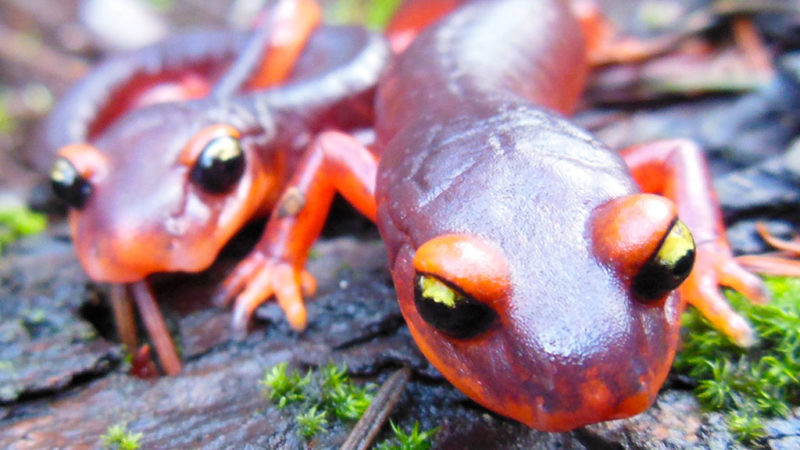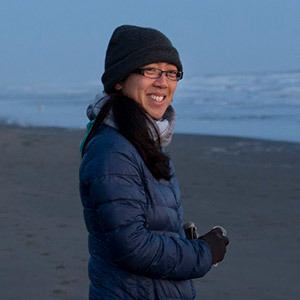
Headline |
IoES Researchers Fight a Salamander Apocalypse
North America’s salamanders could soon face an apocalypse — from a deadly pathogen making its way here through the pet trade.
But who’s leading the charge to protect them through quick action? Researchers from UCLA’s IoES.
A new article in Science by Tiffany Yap, a student in IoES’s Environmental Science and Engineering (ESE) doctoral program and Richard Ambrose, an IoES affiliated professor in UCLA’s Department of Environmental Health Sciences, says that a newly described fungal pathogen endemic to Asia — Batrachochytrium salamandrivorans, or Bsal for short — could devastate North America’s salamander fauna if brought to the continent through the live salamander trade. (It’s already wiping out some salamander populations in Europe, says Ambrose.)
Yap, Ambrose and their three co-authors have modeled the regions where North American salamanders will probably be most vulnerable to Bsal — including close to Los Angeles, one of the continent’s major salamander import centers.
But it’s their article’s call for a temporary federal ban on salamander imports to slow the spread of Bsal that has gotten the researchers a lot of publicity — from NPR to The New York Times to Wired.
Yap’s ESE doctoral work is on the global patterns of both Bsal and Bd — another pathogen that has already proven devastating to frogs and other amphibians globally, including in California. Over the past couple of decades Bd has brought more than 200 species of amphibians to or near extinction while impacting populations of more than 500 species worldwide.
“We have an amazing opportunity to catch this disease early and develop effective protocols to safeguard against it, before it becomes another Bd,” says Yap.
Trying to Buy Time for Science & Salamanders
Bsal was only recognized scientifically in 2013, so there are many gaps in our understanding about its range, behavior and transmission.
Its impact, however, is undeniable: While Bsal doesn’t seem to have caused major die-off in its native Asian habitats — probably because it evolved with those species, says Ambrose — it has already wiped out up to 96 percent of some salamander populations in Europe, landing there through the pet trade.
Globalization of that trade has made it simple for salamanders carrying Bsal to travel halfway around the world in a day. The disease can then spread to wild counterparts, say Yap and Ambrose, if those pets are eventually released into the wild or housed in water and that water disposed of without treatment.
And the need to buy time to understand Bsal better fuels Yap and Ambrose’s belief that the U.S. Fish and Wildlife Service needs to introduce a salamander import ban — and that we need a new world body (a la the Centers for Disease Control or World Health Organization) focused on emerging infectious diseases in wildlife.
“There’s so much we don’t know about Bsal,” says Ambrose, a marine biologist who is working on sea star wasting disease, another virus that was around for decades and suddenly caused epidemic deaths in sea star populations along the west coast of North America over the last two years.
“Have multiple stressors accumulated and made species susceptible to it? Is climate change a factor? There’s a lot of basic science that still needs to be done.”
The modeling work done by Yap, Ambrose and their colleagues is itself a major contribution to potential policy steps against Bsal. They have overlaid the potential conditions on the continent that could support the disease with salamander species richness (the number of species) to narrow down potential vulnerability hotspots to Bsal — the Southeast United States, the Pacific Northwest/Sierra Nevada Mountains and Central Mexico.
Alarmingly, five of the six most significant ports for salamander imports are near or in these hotspot areas — including Los Angeles.
But a salamander catastrophe won’t just be bad for salamanders, says Yap. It could actually make climate change worse, too.
“In a lot of woodland ecosystems in North America, they’re the most abundant vertebrate and also a top predator on the forest floor,” she explains. “They eat a lot of insects and other invertebrates that eat leaf litter, which releases carbon into the atmosphere. The salamanders keep these leaf-litter eaters at bay.”

A Great Example of the IoES Solutions-Seeking Approach
The Science article in part comes right out of Yap’s dissertation project, in which she’s sifting through data on Bd and now Bsal trying to figure out what makes some amphibians susceptible to fungal disease — life history traits, environmental and/or geographical factors.
But it was the ESE program’s interdisciplinary approach, she says, that prompted her to bring science together with a call for swift policy action for salamanders.
“The paper in Science is a mix of science and policy, and it’s a really good representation of what ESE is preparing us to do — connect multiple worlds to solve environmental problems,” says Yap.
“ESE brings in a lot of people with masters degrees in different backgrounds — civil engineering, biology, economics, environmental law — and subjects them to rigorous grad level classes across all those disciplines,” she adds. “You quickly come to understand that systems that seem pretty separate are really interconnected. And that foundation helps you work effectively in real-world situations.”
ESE students do two years of course work, Yap says, and then get a doctoral internship — a full time job in the field in which they want to do work and during which they also complete their dissertation, either for the job or on their own time. The program is geared for students who will work outside academia.
“Working full time is a requirement for ESE, and our students are all over — Army Corps, NOAA, consulting firms, Water Resources Board,” says Yap. “I have a job in Oakland at AECOM, a consulting firm — and that allows us to get life experience in a way that’s really different from academia.”
And Yap and Ambrose are hopeful the publicity their Science article has generated will lead to more life experience for North American salamanders.
“We’re concerned about a conservative, deliberative process by Fish & Wildlife because the longer you wait, the higher the risk Bsal comes to North America — and once it’s here, you won’t be able to put the genie back in the bottle,” says Ambrose.
